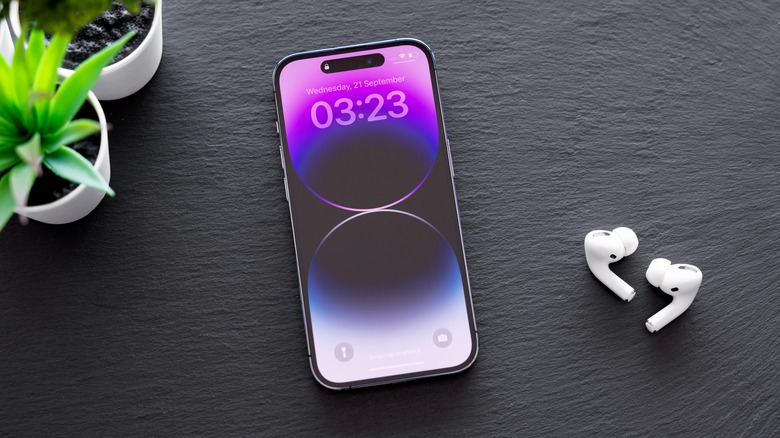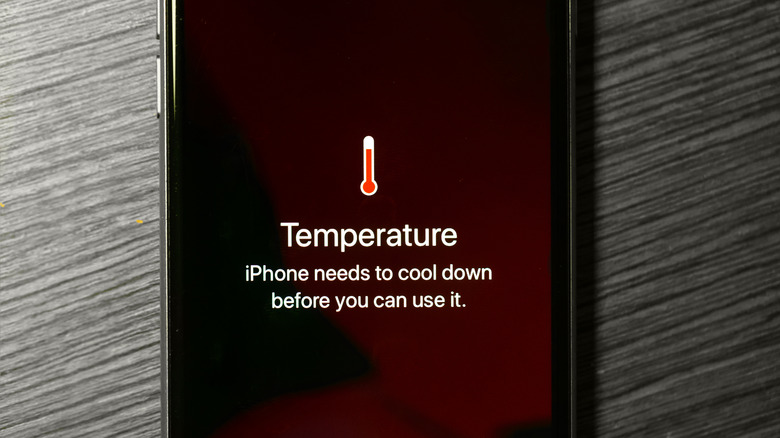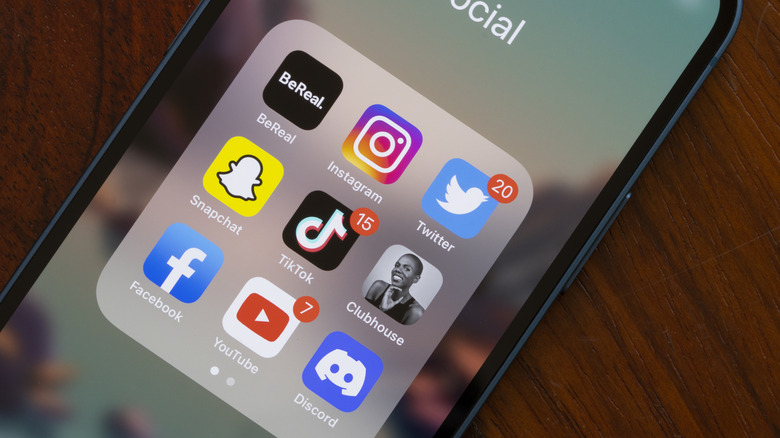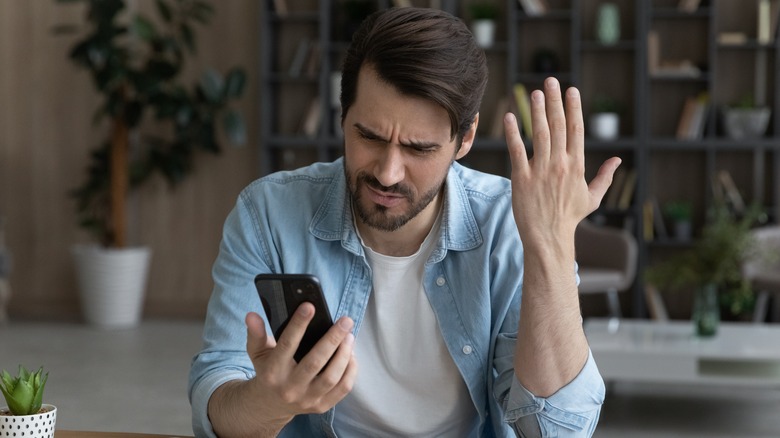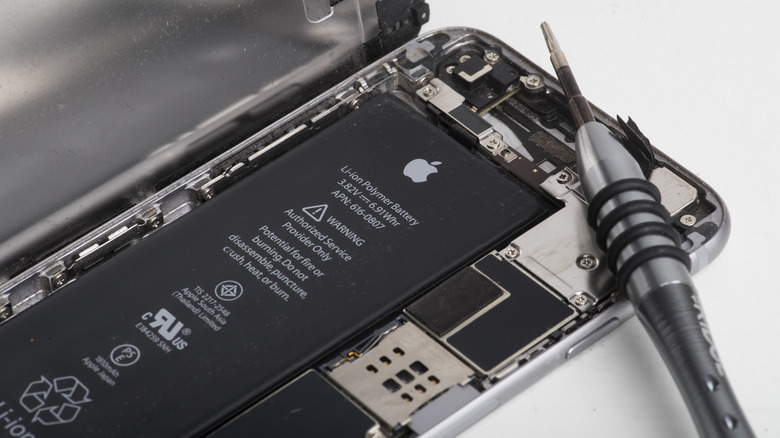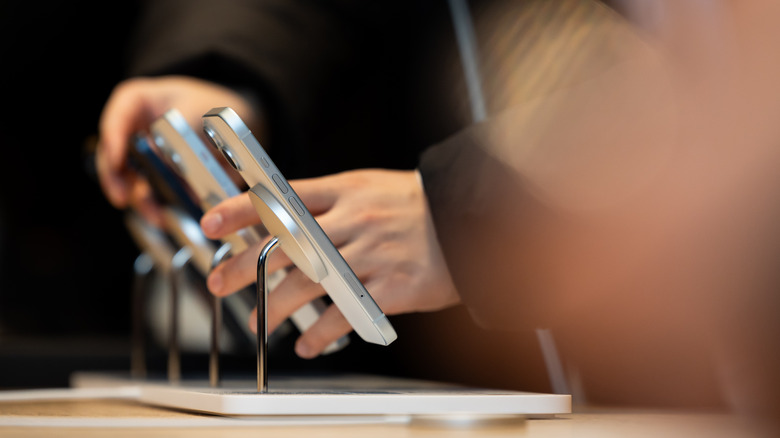Here's What You Need To Do If Your iPhone Starts Overheating
Whether you have one of the latest iPhones, such as the iPhone 15, or an older model, you've probably felt it run a little hot at times. This is normal, and it can happen — especially when you plug your phone in to charge. However, if the overheating seems to happen often or is excessive, you could be dealing with a potentially dangerous problem that could damage your iPhone's internal components. Considering how much an iPhone can cost, that's not something that anyone wants to happen. Fortunately, a lot of the time it's an issue that you can fix by yourself.
The underlying cause behind excess heat in an iPhone usually comes down to software or environmental reasons. For example, if you're lounging on the beach and watching YouTube on your iPhone, it most likely won't thank you. Similarly, sometimes the fact that your phone feels warm to the touch is nothing to worry about. In this article, we'll take a look at some of the reasons why an iPhone can overheat, how to tell if the warmth is concerning, and how to get it fixed without having to pay for repairs.
How to tell if your iPhone is really overheating
The first step in figuring out the issue is to determine if your phone is actually overheating or not. Based on environmental factors, your phone may sometimes feel warmer to the touch than others. That doesn't always mean that your phone is actually overheating. Overheating is when the phone's temperature stays too high for an extended period of time and can cause both short- and long-term damage. While leaving it in the sun while you're on that beach isn't great, you don't need to panic just yet.
You know that your iPhone is overheating when it's inhibiting your ability to use it. There are some signs to look for, including the screen going dim or black, charging ports no longer working as they previously had, the camera flash no longer working when you take a picture, or a slower performance when loading apps.
Your battery life itself is also a good indicator. If you can normally use your phone for most of the day without recharging it, but suddenly the battery is drained in two hours, that is a sign that your phone might be overheating. It's important to be able to recognize the difference because an iPhone that regularly overheats needs to be repaired. This may mean taking it in to be fixed, but before you take that step there are some at-home fixes you can consider.
Overheating from overuse
While iPhones are generally considered everyday use items, there can still be a point where it's being used too much. What you're doing on your phone also plays a part in that. If you're streaming high-quality graphics for the purposes of playing a game or watching movies for hours and hours on end, your phone may be unable to cope with the demand. These types of activities are a drain on the internal workings of the phone which raises the temperature inside. You may even see a temperature warning screen appear when using your phone.
The most obvious solution to fix this type of overheating is to ease up on how much you're using it. Leaving your phone asleep or turning it off completely for a few hours a day could make all of the difference, and save you the annoyance of having to make an appointment to have it repaired. You can also make sure that background activity is turned off for high-traffic apps, including location services.
To avoid overheating, in particular, it's important not to use any resource-heavy apps when you're out in the sun. Playing games or watching videos will heat up the phone on its own, so avoid doing it in high temperatures, but also while charging the iPhone, as this also can lead to overheating.
Overheating due to poor signal
Having a poor Wi-Fi or cellular signal can have the same effect as using your phone too much. When your phone has to work to get the reception that it needs to load games, media, or apps then things on the inside start to get a little toasty. If you're relying on the connection from your service provider and you're somewhere where Wi-Fi is available, switch to Wi-Fi. However, if you're in a location that has no Wi-Fi, or both Wi-Fi and data indicators are low, you still have some options.
Try to pre-load as much as you can while you do have good service or Wi-Fi. This works especially well if you're using your phone in so-called service deserts, such as when you're on a plane or train journey. By downloading and having the videos on your phone before you set off, you spare your device the effort of trying to scrounge for signal. Most streaming services offer some sort of download for offline viewing option, but as an iPhone user, you might want to purchase videos and music in the iTunes app on your phone directly. As of iOS 17, Apple even lets you download maps for offline use.
Overheating due to battery issues
As your iPhone ages, the battery inside it degrades over time. This kind of chemical aging can degrade the battery life, making your phone last less time between charges. While this is frustrating, it's also a natural part of the iPhone life cycle, and, unfortunately, it happens gradually. It's when this happens suddenly out of nowhere, combined with a hot phone or a warning about high temps on your phone's screen, that you need to worry.
Once your iPhone's battery is damaged, there may not be too much you can do. Preventative measures are key in this kind of issue. To extend the battery life of your iPhone and keep overheating issues at bay, make sure your phone stays within the correct ambient temperature range (between 62° and 72°F). If you're unsure about how bad your battery has already gotten, there are ways to check the battery health.
When there's no issue besides continuing to use your phone with a battery that's acting up, you can try putting it in Low Power Mode. This will help conserve the battery life and make it do a little less work to keep your phone on and from overheating. However, at some point, you might need to consider battery replacement — especially if the back of your phone is swelling up.
What to do if nothing else helps
If the tips listed above didn't help, it's time to dig deeper. One benefit to using an Apple product is that the company has an extensive support forum network available online. The responses are a combination of user contributions and licensed Apple technicians responding with company-approved advice. When asked about a problem with the iPhone overheating, the support forums have some advice. A few of these have been covered previously, and the rest are good steps to take before seeking out in-store assistance.
Next, check and see if any software updates are available. Often Apple will release iOS updates that fix battery-damaging glitches or bugs. You can also look and see if any of your apps are using an inordinate amount of battery life. Just turning background loading off on a few of those may go a long way. While you're flipping those switches to gray, also take a look at other features you may not be using. For example, using location services will always drain your battery, as will the camera.
Finally, as a last resort before consulting Apple's Genius Bar, you can try to do a factory reset. If the issue stems from an app or software problem, putting your iPhone back into factory settings may work. Just make sure you do a backup beforehand if you don't want to lose all of your data! If none of these work, then you can contact Apple and see about getting a new battery.
